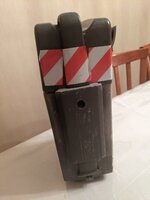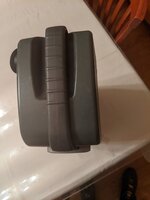Ebike batteries are welded up from individual cells. On Lithium ion batteries the welding is a dangerous process which can lead to a huge chemical fire if the arc or flame penetrates the battery case. I suggest one leave the welding of LiIon cells to trained people in a foreign country. Definitely not something that should be done indoors in a residence or apartment. Stacks of cells pressed together, as D cells in a radio, do not make a reliable connection at the 4 amps per stack that e-bike grade cells should put out. Lead acid batteries are cast or wound, then inserted in a rubber molded case which is glued to a plastic molded top. Taking the insides out & replacing them is not done.
I bought my bike battery as a unit, then wrapped in a shell of aluminum angle so I could mount it to the bicycle. You apparently have a used battery where the battery is wrapped in a plastic molding. This molding can be sawed off, but can't be replaced by any process involving a machine costing less than $300000. Whereas you can buy aluminum angle at the home store, saw it up in to appropriate legs, drill holes, and screw them together with #10 or 5 mm screws. The battery itself is wrapped in a piece of heat shrink plastic, the 8" variety available from ali. I further wrapped my battery in sheet packing foam to insulate it from cold, and then heavy plastic bag to keep the rain off and disguise it. My bag is green.
Your battery shows a voltage of 12.6 to 14.something. This is an extremely obsolete battery. You can still buy scooter batteries of that kind, which are usually lead-acid technology that doesn't offer much energy density or range. It won't have the mounts matching your original battery. Enclosing the scooter battery in a cage that can be screwed to any part of the bike is up to you. I used aluminum angle. Steel would also work. I pointed the screw ends out so the screws wouldn't wear holes in the battery. The foam wrapping I put around my battery allowed me to get a long screwdriver in from the opposite side and hold the screws while I tightened the nuts on the outside. I used elastic stop nuts from mcmaster.com so the nuts wouldn't fall off. I used stainless steel screws & nuts so they wouldn't rust in the rain. My battery cage has been assembled now for 4 years, and hasn't come loose. Wannabe thieves have loosened one or two nuts while I was inside the store shopping, but never completely removed even one because elastic stop nuts fight you all the way off. My battery cage has 24 screws & nuts. Mcmaster.com sells screws & nuts in boxes of 50 or 100 each. Alternate sources are grainger.com and fastenal. Freight is usually higher on grainger because they ship each item from a different warehouse. Mcmaster only has two warehouses and 80% of orders come in one box, for as low as $9 freight for small items.
Happy designing and building.




